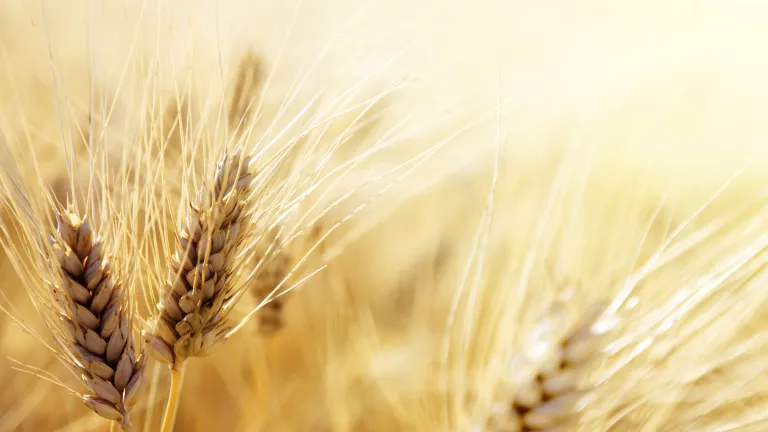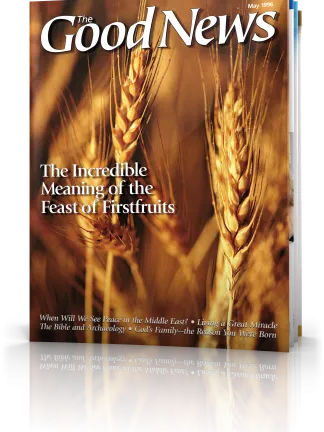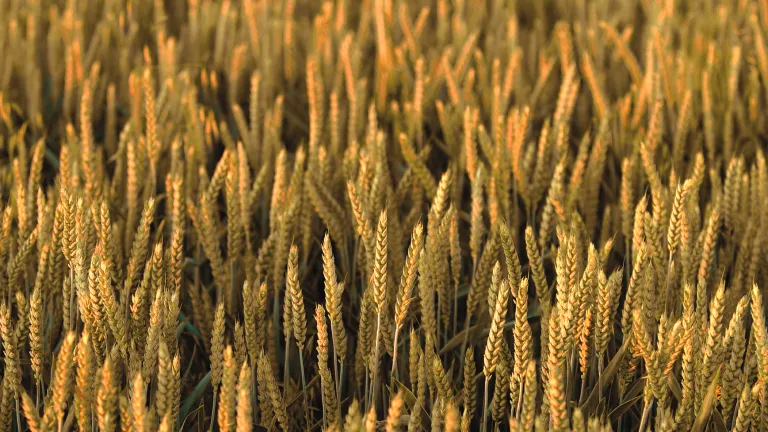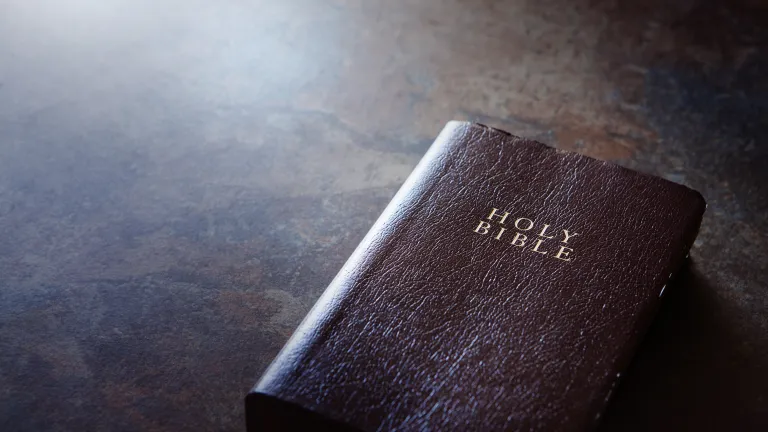The Wave Sheaf Offering: A Ceremony Foreshadowing Salvation

In ancient Israel, the beginning of the spring grain harvest was marked with an unusual ceremony—the waving of the first sheaf of grain to be accepted by God. This simple act holds great spiritual significance!
The agricultural cycle of ancient Israel revolved around two harvests, one in the spring and the other in the autumn. Before any grain could be harvested in the spring, an unusual ceremony took place to inaugurate the spring harvest season.
Pentecost is an annual reminder of the coming of the Holy Spirit and the beginning of the Church. However, the festival holds even more significance. A clear understanding of the events leading up to the Feast of Pentecost makes its importance much more clear.
This ceremony was the waving of the first sheaf of grain to be accepted by God. Instructions for this ceremony are detailed in Leviticus 23:10-14. No one was to eat any of the grain of the harvest until the first sheaf of the harvest was brought to the priest, who in turn waved it before God.
What was the significance of this ceremony?
Jesus Christ "the firstfruits of those who have fallen asleep"
This first sheaf of grain was called the "firstfruits" (Leviticus 23:10). It was the firstfruits of the barley harvest, the first part of the grain harvest. Thousands of years later, we find the same term used again in the Bible-describing Jesus Christ! "But now Christ is risen from the dead, and has become the firstfruits of those who have fallen asleep" (1 Corinthians 15:20, author's emphasis throughout).
We also find that Jesus Christ is called "the firstborn over all creation" and "the firstborn from the dead" (Colossians 1:15-18). The apostle Paul said that Christ was prophesied to be "the first to rise from the dead" (Acts 26:23).
What is the connection between the first grain offering, called the firstfruits, and Jesus Christ, the firstfruits and firstborn from the dead?
This understanding is tied in with the symbolism of the two harvests mentioned earlier and the Feast of Pentecost, observed at the conclusion of 50 days that began with the day of the wave-sheaf offering. On Pentecost, two loaves were offered from the firstfruits of the wheat harvest, which followed several weeks after the barley harvest.
For a fuller understanding of the symbolism of the two harvest periods, be sure to read "The Lesson of the Feast of Firstfruits". The article shows that, just as there were two periods of physical harvesting in ancient Israel, so there would be two periods of spiritual harvesting in God's great plan for the salvation of humanity. This astounding truth is shown through the symbolism of the Feast of Pentecost.
Meanings of Pentecost
Pentecost has several meanings, each significant in its own right. The word Pentecost means "fiftieth (day)." In the Old Testament, this festival was known as the Feast of Weeks (seven complete weeks plus one day, Leviticus 23:15-17; Deuteronomy 16:10, Deuteronomy 16:16). It was also called the Feast of Harvest or Firstfruits (Exodus 23:16; Exodus 34:22).
The word firstfruits suggests an initial harvest that will be followed by another harvest. The firstfruits of the wheat harvest are preceded by the wave-sheaf offering of the earlier-ripening barley harvest. The wave sheaf is symbolic of Jesus Christ.
Pentecost is an annual reminder of the coming of the Holy Spirit and the beginning of the Church (Acts 2:1-4). However, the festival holds even more significance. A clear understanding of the events leading up to the Feast of Pentecost makes its importance much more clear.
Pentecost deals directly with our salvation, our ability to follow Christ's example through the power of God's Holy Spirit and our capacity for understanding God's spiritual truth through His Spirit (1 Corinthians 2:10-14).
None of this understanding is possible without the fulfillment of the wave-sheaf offering: Jesus Christ's acceptance by God the Father.
Wave-sheaf offering a forerunner
The wave-sheaf offering was the forerunner of an additional offering brought later, on the Feast of Pentecost. On Pentecost, two loaves of bread, "the firstfruits to the LORD," were offered (Leviticus 23:16-17).
As the wave-sheaf offering represented Jesus Christ, so did these loaves represent God's spiritual firstfruits, those who are called and faithfully obey God in this life (Romans 8:24; James 1:18). As the wave-sheaf offering was the necessary forerunner of the Pentecost offering, so was Jesus Christ the necessary forerunner of God's people, who are His spiritual firstfruits.
These symbols demonstrate how God's Holy Days relate to each other and are designed to convey the interdependence of the events in God's plan for humanity.
For example, Passover is the first of God's annual festivals (Leviticus 23:5). God's plan for the salvation of mankind is built upon the death of Jesus Christ our Passover(1 Corinthians 5:7), as the atoning sacrifice for humanity (John 1:29). Christians cannot attain to everlasting life without Christ's sacrifice, which reconciles us to God.
The wave sheaf, offered during the Feast of Unleavened Bread (Leviticus 23:6-11), portrays a resurrected Jesus now serving as our High Priest (Hebrews 4:14). Without the prior sacrifice of Jesus Christ, the fulfillment of Pentecost-the calling and salvation of the firstfruits, those in God's Church-could not occur.
Christ's return to the Father
Let's notice a few scriptures that demonstrate these points.
The Israelites' harvest season could not begin until the wave-sheaf offering was made to and accepted by God. In like manner, the Holy Spirit was not poured out on humanity until after Jesus returned to the Father (Acts 1:1-8; Acts 2:1-4). Jesus Christ Himself had told His followers that He had to leave before the Holy Spirit could come to them (John 16:5-14).
Even after His resurrection, Jesus Christ had to tell His followers not to touch Him until after He had gone to His Father (John 20:17). Only after Jesus had risen to the Father and returned to them again were they allowed to touch Him (John 20:19, John 20:26, John 20:27).
Notice the apostle Paul's depiction of Christ, our resurrected wave-sheaf offering: "If then you were raised with Christ, seek those things which are above, where Christ is, sitting at the right hand of God. For you died, and your life is hidden with Christ in God. When Christ who is our life appears, then you also will appear with Him in glory" (Colossians 3:1-4).
Paul reveals that our Savior occupies a place for us in the very presence of our Father and that we are accepted by Him through Christ Jesus.
Symbols of firstfruits ceremony all pointed to Christ
In addition to the wave-sheaf offering, the other sacrifices and offerings commanded by God at the time of this ceremony also pointed forward to Jesus Christ.
Jesus was represented by a male lamb without blemish (Leviticus 23:12), which was symbolic of Christ's spiritual purity. Christ was called "the Lamb of God who takes away the sin of the world" (John 1:29).
He was also represented by fine flour (Leviticus 23:17), symbolic of the beating, scourging and suffering through which He was perfected (Hebrews 5:8-9). This fine flour was to be mixed with oil (Leviticus 23:13), representing Christ's being filled with the Holy Spirit.
The lamb was to be a burnt offering, totally consumed by fire (Leviticus 23:12). In the same way, Jesus Christ was tested and tried in the crucible of life's trials and problems and then He surrendered Himself totally and completely as a sacrificial offering on our behalf (Hebrews 10:12). His supreme sacrifice was as a sweet aroma (Ephesians 5:2; Leviticus 23:13) to God because Jesus had given Himself voluntarily and unconditionally for sinful mankind.
Those who keep the Feast of Pentecost appreciate the relationship to Pentecost of the wave-sheaf offering. Without the true wave-sheaf offering, Jesus Christ, there would be no Holy Spirit to lead us, no Church to spiritually nurture us and no harvest for the salvation of humanity.
The accompanying drink offering of wine (Leviticus 23:13) was symbolic of Christ's pouring out His blood to pay the penalty for our sins (Matthew 26:27-28; 1 John 1:7).
The very day of the wave-sheaf ceremony pointed forward to Christ. History records that the sheaf was harvested on Saturday night, which began the first day of the week. It was then waved before and accepted by God on the first day of the week (Sunday) during the Feast of Unleavened Bread (Leviticus 23:11).
As mentioned earlier, Jesus Christ, after His resurrection, would not let His followers touch Him until He had returned to God the Father (John 20:17). Later that same day, after He went to the Father, they could touch Him (John 20:19, John 20:26-27).
This occurred on the first day of the week (John 20:19), the Sunday during the Feast of Unleavened Bread (Matthew 26:2, Matthew 26:17; Matthew 28:1). The wave-sheaf offering foretold the precise day of the week Christ would return to the Father more than 1,400 years before that day actually occurred!
These astounding parallels give us a much deeper appreciation of the significance of the wave-sheaf offering God commanded. Reading Leviticus 23:10-14 with this understanding helps us to better grasp both Jesus Christ's supreme importance in God's plan as well as the meaning of the wave sheaf. Without a Savior who would give His life and be resurrected to life again, there could be no later harvesting of humankind for salvation.
Christ's purpose foretold
Almost 1,500 years later, Jesus Christ explained His purpose to His followers, using the analogy of grain: ". . . 'The hour has come that the Son of Man should be glorified. Most assuredly, I say to you, unless a grain of wheat falls into the ground and dies, it remains alone; but if it dies, it produces much grain'" (John 12:23-24). This imagery connects Jesus Christ's sacrifice to the salvation of all mankind: Only if Jesus Christ gave His own life could more life-additional sons of God-be produced (Romans 8:29; Hebrews 2:10).
Christ's role as depicted by the wave-sheaf offering differs somewhat from His role as depicted by the Passover sacrifice. Both reflect different aspects of His sacrifice and purpose in God's plan for the salvation of humanity.
During His crucifixion, Jesus Christ declared that His sacrifice, as foreshadowed by the Passover, was completed: "So when Jesus had received the sour wine, He said, 'It is finished!' And bowing His head, He gave up His spirit" (John 19:30).
Christ wasn't saying that God's plan for saving humankind was finished at His death. He was saying that the crucial, all-important giving of His life as our Passover sacrifice was finished. The death of Jesus Christ meant that mankind could and would be reconciled to God the Father.
But, beyond that sacrifice, there is another vital aspect of our salvation that is not yet complete. Jesus Christ's sacrifice alone, through His crucifixion, did not and does not save humankind. It did, however, reconcile humanity to God. Beyond this reconciliation lies another truth signified by the wave-sheaf offering: "For if we were reconciled to God through the death of His Son, much more, having been reconciled, we shall be saved by His life" (Romans 5:10).
As the Passover precedes the wave-sheaf offering, so reconciliation precedes our salvation. We are saved by Christ's resurrected, divine life.
All made possible through Jesus Christ
Those who keep the Feast of Pentecost appreciate the relationship to Pentecost of the wave-sheaf offering. Without the true wave-sheaf offering, Jesus Christ, there would be no Holy Spirit to lead us, no Church to spiritually nurture us and no harvest for the salvation of humanity.
Through these things, God continually assures and reminds His people that we have the promise of eternal life through the gift of the Holy Spirit. This promise was made possible through God, who resurrected and accepted Jesus Christ, our wave-sheaf offering.







